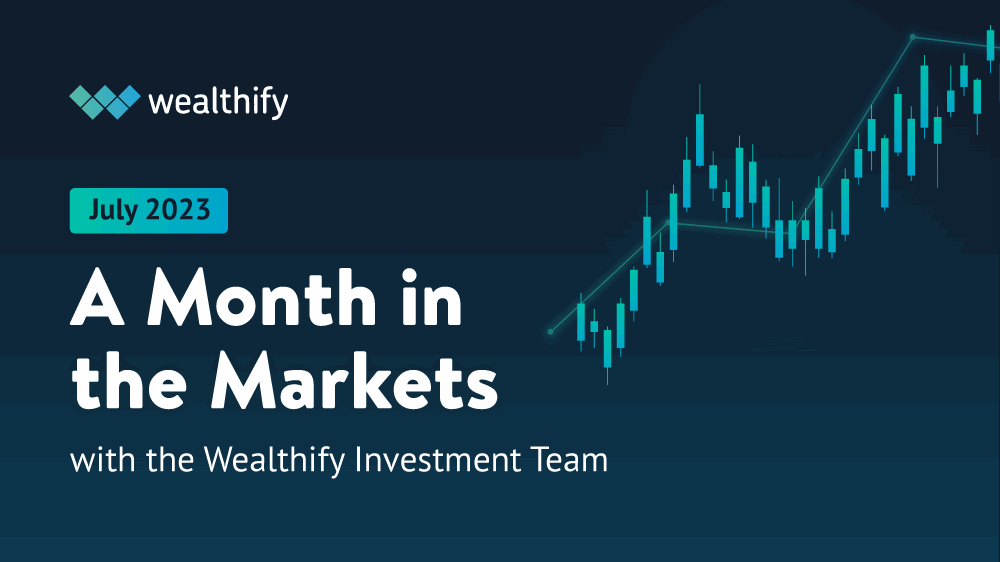The Month in a Minute
📰 Overall: July saw global markets benefit from positive momentum, resulting in a promising month for Plans across the board.
💪 Benchmark Performance: Our Plans continued to outperform their benchmarks in July and 2023 to date, with asset selection a key driver of performance.
📈 Market Movers: MSCI (Morgan Stanley Capital International) China index (+9.3%); emerging market shares (+5.8%).
📋 Plan Summary: Plans with a higher allocation to shares performed better than those with more lower-risk assets.
🌍 Original Plans: Shares (+3.1%); bonds (+0.5%).
🌳 Ethical Plans: Shares (+2.0%); bonds (+0.9%).
⏲ Going Forward: We’ll continue to proceed with caution by favouring more defensive assets, but remain watchful of long-term opportunities in bonds and equities.
Global markets benefitted from positive momentum in July, as economic growth and falling inflation fuelled stories of a ‘soft-landing’. However, we think this scenario where inflation comes down, but economic growth and labour market remain buoyant, is unlikely.
We continue to be cautious, favouring less risky assets such as bonds.
1.) We believe we are near or at the peak of interest rates in the developed world.
2.) They offer strong risk-reward in times when the economy and corporate earnings come under pressure.
"Our Plans continued to outperform their benchmarks in July and 2023 to date, with asset selection a key driver of performance; we favour long-term opportunities in bonds and equities but, with all signs pointing towards and economic slowdown, are also leaning towards less risky opportunities.”
— Kyle Cox, Deputy Chief Investment Officer
In the US, inflation was down from the previous month (4.9%), settling at 4.0%. This strong downturn came mainly from the disinflation related to oil prices, which peaked in June last year.
Core inflation (which excludes more volatile components such as energy) came in ahead of expectations at 5.3%. This will continue to bother the US Federal Reserve (The Fed), promoting higher interest rates for longer to reduce the risk of more permanent inflation.
In the US, inflation was down from 4.0% the previous month, settling at 3.0%. Core inflation (which excludes more volatile components such as energy) came in below expectations at 4.8%.
The better-than-expected inflation numbers were well received by markets, as investors quickly adjusted their expectations of future interest rates downwards. Strong economic growth numbers created further momentum, with an increasing belief that inflation could return to 2% while maintaining robust economic growth (a ‘soft landing’).
In Europe, inflation was a little more mixed. Headline inflation fell from 6.1% to 5.5%, but core inflation rose slightly from 5.4% to 5.5%. The economy is cooling, with manufacturing and services shrinking. There is a growing possibility that the European Central Bank (ECB) will pause rate hikes at its next meeting, despite the increase in core inflation remaining an issue.
UK inflation fell faster than expected to 7.9% from the previous month’s 8.7%; core inflation also came in better than expected at 6.9%. This will be welcomed by the Bank of England (BoE), potentially paving the way for smaller increases than we saw in June.
A very tight labour market remains in the spotlight for the BoE, with strong wage growth still a major issue. According to Bloomberg data, however, we did see the number of employees on payrolls decreasing by 9,000 in July, which was below expectations and the expected peak interest rates has been revised downwards, but more will still need to be done by the BOE to bring inflation into acceptable ranges quicker.
Markets
In July, global shares delivered another healthy return of 3.6%, while global bonds delivered a return of 0.7%. (5.8%) outperformed developed market shares (3.3%), as positive sentiment spread more broadly to riskier share markets.
Increasing confidence in the current and future state of the global economy was the main driver of investors taking increasing risk, highlighted by the performance of the Chinese share market (which has been plagued by negative sentiment in recent times).
The MSCI (Morgan Stanley Capital International) China index gained 9.3% in July, driving emerging market returns as investors shrugged of economic and political concerns.
Elsewhere, returns were more moderate, as US shares and the S&P 500 index posted a gain of 3.1% in July. The UK was not far behind, as the FTSE 100 (larger companies) and FTSE 250 (small and mid-sized companies) delivered returns of 2.2% and 3.9%, respectively. Europe and Japan were slightly less positive, with their share markets gaining 2.0% and 1.4%, respectively.
Currency
Due to an increased appetite for risk amongst investors, the US dollar depreciated. When there’s fear, the US dollar – which is generally seen as a safe store of value – generally gains in value (and vice versa). Added to this were positive inflation numbers in the US, which saw lower expectations of future interest rates.
Sterling also gained by 1% against the dollar, remaining relatively unchanged against the euro (+0.2%) and Japanese yen (-0.4%).
Investment type performance breakdown
In our Original Plans, shares (+3.1%) delivered positive returns, driven by strong returns from the US, which was enhanced by sterling hedging. Bonds (0.5%) also delivered positive returns, mainly due to falling bond yields in the UK. Alternatives also performed well, with property and infrastructure gaining 2.2% and 1.5%, respectively.
Ethical shares provided more moderate positive performance, with shares (+2.0%) driven by US share exposure, particularly the sterling hedged portion. Bonds (0.9%) also made decent gains on the back of lower-than-expected inflation data.
Summary with Plan details
In July, Plans with a higher allocation to shares performed better than those with a higher allocation to lower-risk assets. Our Investment Team continues to actively monitor the financial markets and their impact on Plans — and are always ready to act in your best interests to events as they unfold. We are continually evaluating new market information and key market drivers to help keep your Investment Plan on track.
It’s important to remember that it’s normal for markets to go up and down, with periods of volatility to be expected when you invest. As always, we continue to look for opportunities to position your investments, with the goal of protecting your money and achieving your long-term objectives.
Wealthify does not provide financial advice. Please seek financial advice if you are unsure about investing.
Please remember the value of your investments can go down as well as up, and you could get back less than invested. Past performance is not a reliable indicator of future results.



